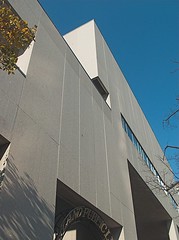 Portland's main library will be shutting down for most of March as the building gears up for a year-long period of construction and renovation. When the first phase is finished in 2010, Monument Square will look something like the rendering above.
Portland's main library will be shutting down for most of March as the building gears up for a year-long period of construction and renovation. When the first phase is finished in 2010, Monument Square will look something like the rendering above.
I've written before about how much I love our library building - a beautiful (and Portland's only) example of international modernism.
How we use libraries has changed dramatically since the library was built in 1979, and the renovation will do a great deal to bring the building up to date.
New floorplans will give more space for Internet browsing and kids' and teens' services. The Rines Auditorium will be relocated towards the front of the building, which will allow direct access to the room later in the evenings when the rest of the library is closed.
The biggest improvement, though, comes from enclosing the empty space in the front of the building, where there are currently only skylights under an overhang of the building. This inactive space is the biggest shortcoming of the existing building: walking past the skylights along Congress Street, you look through the windows and see only a ceiling mural in the childrens' library. It feels more like a suburban office park than the central square of the city, and it has a deadening effect on the street.
The renovations will enclose the empty space with glass and turn it into a cafe, where library users can work in a sun-filled space with big windows onto the Square, and where the library will be able to make a little bit of money by selling coffee. Inside and out, the front of the building will feel a lot more lively and welcoming after these renovations.
I have only a couple of minor quibbles with the plans for the front façade. I find it a bit unfortunate that the renovation will mar the building with a "solar chimney" - a tower of glass tacked onto the granite. But it will save the library a lot of money for heating costs, according to architect Scott Simons:
The tall angled glass curtainwall on the front of the library (the uppermost portion) is actually a greenhouse that generates pre-heated air for the mechanical system. The sun penetrates the single glazing, heats up the air and stone behind it, then rises naturally to the top of the chimney where it is drawn into the air mixing chamber in the mechanical system as heated fresh air... The glass curtainwall greenhouse saves enough energy to pay for itself in less than ten years.It might not look great, but the energy savings is a noble goal, and with luck the glass can come down sometime in the future when even better heating options are available and the city has better appreciation for the existing building's elegant modernism.
I'm also uncertain about the new façade's other prominent element, an outdoor video screen above the main entrance, facing Monument Square. On the one hand, I've always been a fan of the library's kiosks that line the entrance ramp, where any individual or organization can put up a display for all to see, and the outdoor screen gives that egalitarian concept an even grander stage outdoors on Monument Square. It also would be neat to have for civic celebrations - this outdoor screen would have been fantastic to have on Election Night, or when the Red Sox won the World Series. But, on the other hand, I'm concerned that a big outdoor video screen could be pretty tacky most of the time - more Times Square than Monument Square.
Still, these are minor complaints, and I'm put at ease by the fact that they're by no means permanent alterations to a beautiful building. All in all, I'm really looking forward to the library's rebirth, and a newly revitalized Monument Square.







 Learn more, and find out where you can purchase a copy.
Learn more, and find out where you can purchase a copy.